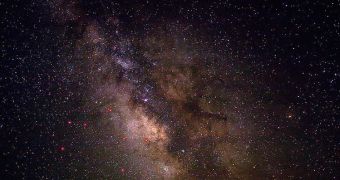An advanced model running on an American supercomputer has revealed the existence of a satellite galaxy around the Milky Way. When astronomers looked for it in real-life, they found traces that may indicate its presence. The model is now used to find other galactic companions as well.
Astrophysicists have proposed some time ago that massive spiral galaxies such as our own must have tens to hundreds of companion galaxies, that are either too small or too faint to discern in the night sky.
The Small and the Large Magellanic Clouds are two examples of visible dwarf galaxies orbiting the Milky Way, but they are quite large in their own right. What researchers were interested in were smaller cosmic structures, whose main components may be dark matter.
Sukanya Chakrabarti, then an expert at the National Energy Research Scientific Computing Center, used NERSC supercomputers to simulate mathematical models of our galaxy and its surroundings.
The expert was successful in identifying a large number of dark companions. One of them, she said, is located opposite to Earth, on the other side of the Milky Way. It is located some 300,000 light-years away from the galactic center.
“Our approach has broad implications for many fields of physics and astronomy – for the indirect detection of dark matter as well as dark-matter dominated dwarf galaxies, planetary dynamics, and for galaxy evolution dominated by satellite impacts,” Chakrabarti explained.
She presented the results of her simulations earlier this year in Seattle, at the American Astronomical Society meeting. The work was conducted when the expert was still a postdoctoral researcher at the University of California in Berkeley (UCB).
Chakrabarti is now an assistant professor of physics at the Florida Atlantic University. “The NERSC systems really sped up my work. These systems are a great resource,” she says.
“I am currently using my method to develop a test of modified theories of gravity, and plan on running the simulations at NERSC,” the expert adds. She collaborated closely with NERSC Analytics team member Prabhat in creating a 3D movie of the simulation.
“When a person looks up at the night sky from Earth, they can’t tell the difference between a star that is far away and one that is nearby,” Prabhat explains, quoted by experts with the Berkeley Lab Computing Sciences department.
“It is the same when you are running simulations on a flat screen, you see bands that stretch in and out but you don’t get the depth that a 3D visualization provides,” concludes the expert, who was a graphics system analyst at the Center for Computation and Visualization (CCV) at the Brown University.
NERSC is a user facility located at the US Department of Energy's (DOE) Lawrence Berkeley National Laboratory (Berkeley Lab), in California.

 14 DAY TRIAL //
14 DAY TRIAL //